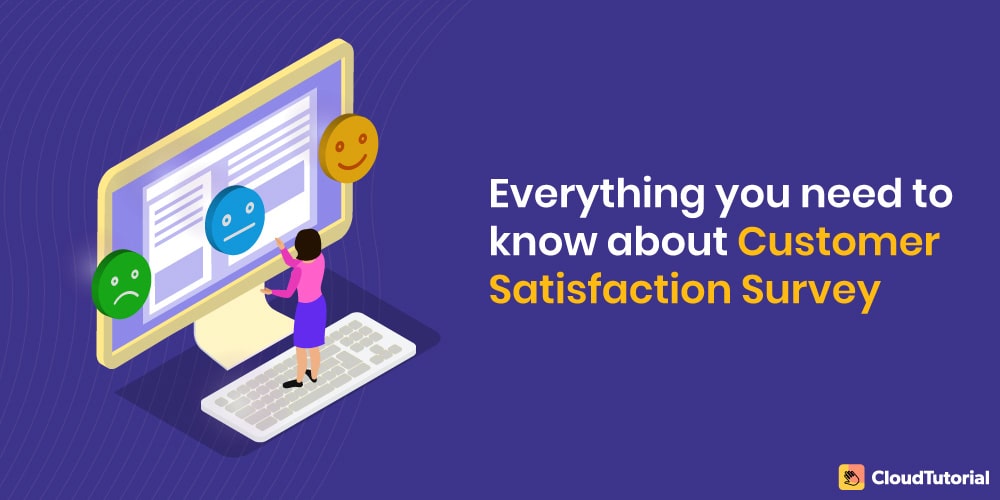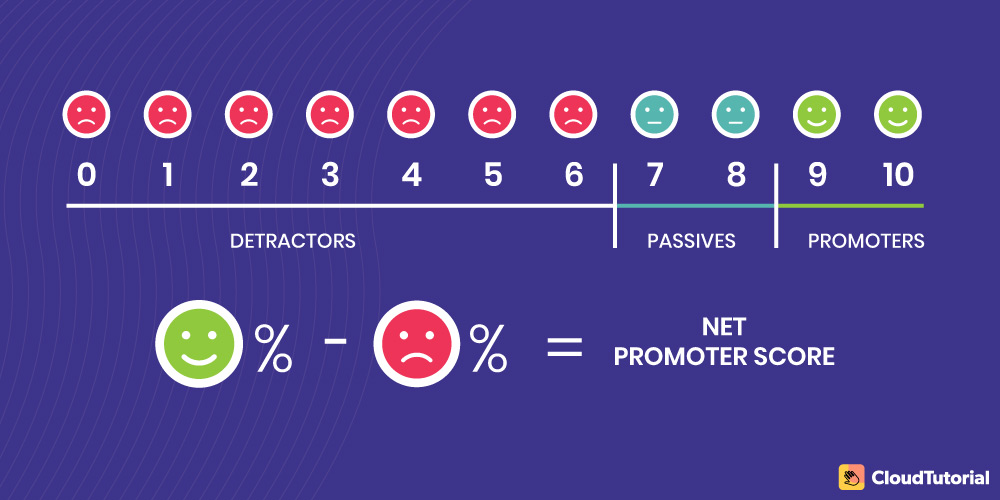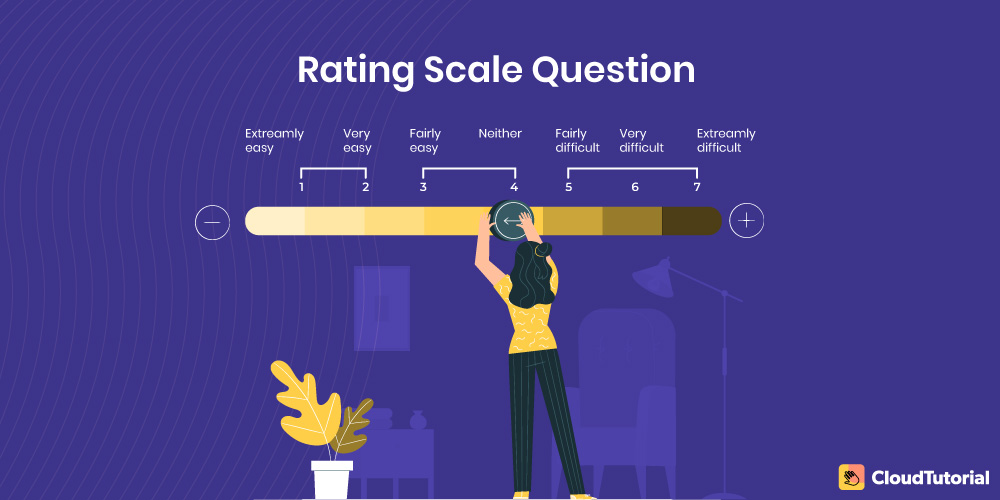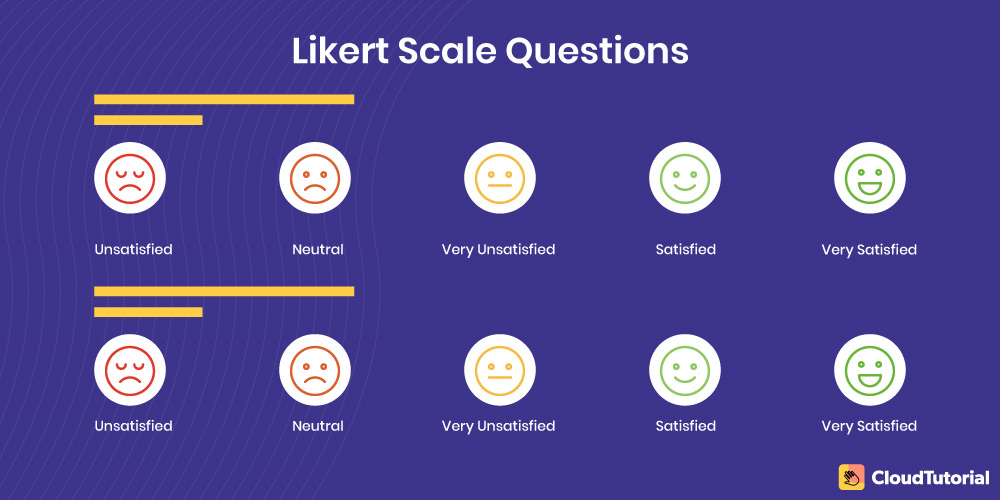If you are having a customer-centric company, then knowing how satisfied are your customers is very important. A customer satisfaction survey can be conducted to understand what your users are thinking about your brand, product, customer service, and support.
Through such surveys, you can get vital information about your customers. This helps you take proactive steps to enhance customer experiences with your services. Let’s examine the concept of these surveys and accomplish better retention rate, sales opportunities, and loyalty.
Table of Content
What are Customer Satisfaction Surveys?
Customer satisfaction (CSAT) surveys are exercised to understand the customer’s satisfaction level with the organization’s experiences, services, or products. This is a kind of customer experience survey and can be utilized to comprehend issues with products or services, divide consumers by their score, or measure customers’ needs.
Usually, rating scales are used to measure variations over time and thereby, acquire a profound understanding of whether you are fulfilling the customers’ expectations or not. It is a questionnaire produced to aid businesses to recognize customer sentiment about their brand and customer service.
Such surveys permit companies to optimize user experience, develop products tactically, and convey as per the market demands.
Types of Customer Satisfaction Surveys
Various customer satisfaction surveys can be conducted to assemble customer responses. From these analyses, you can ascertain if your users’ are loyal, satisfied, and happy with your product or service. In this way, you can learn about your customers’ experience.
Each type of survey provides distinctive customer insights and must be utilized at an explicit point in the customer experience lifecycle. The most operative surveys you can employ to understand your users are as follows:
Net Promoter Score
Net Promoter Score (NPS) is one of the most well-known surveys to ascertain the feedback of consumers concerning your offerings. It is, in fact, a swift survey where you could question your customers’ general query of whether they would like to mention your products to their networks along with requesting them to rate your offerings from 0 to 10.
Then, you can compare your proportion of ‘detractors’ (0-6 answers) to that of ‘promoters’ (9-10 answers) to realize where your business stands. The more ‘promoters’ you possess, the more you can conclude that people are pleased with you.
Consequently, you can clearly understand if your customers are content with your services or not. If they are truly happy with your services or product, they can act as your ‘brand advocate’.
Customer Satisfaction
CSAT is a metric utilized to measure your customers’ satisfaction level with your services and products. It assesses how content they are with your services. Here, you can request your customers a usual customer satisfaction survey question to score their general contentment level with your offered services or products.
You can ask them to rate from 1 to 5; where 5 indicates ‘highly satisfied’ and 1 means ‘highly unsatisfied’.
From these ratings, you can classify how many individuals are unsatisfied, satisfied, and highly satisfied with your services. In such a manner, you can enhance your services and transform ‘unsatisfied’ ratings to ‘satisfied’ ones.
Product Development Survey
A product development survey is considered to be unique as it attempts to recognize what customers require in the future, in place of how they truly feel in the present-day. This is sometimes identified as ‘concept testing’ and is executed before you begin or launch building a new product to get an understanding of how much curiosity is there in this new one
Because the last thing you ever want to do is devote loads of money and time to projects that fail to content customer requirements and expectations. To execute this survey, you need to show customers a model of the product you are building, either online or in-person, comprising the price. And then you ask questions about the actual product.
Post-purchase Survey
A post-purchase survey is usually sent after consumers buy a service or product from your enterprise. These are meant to determine the customer experience, specially during their dealings.
Dissimilar to the NPS survey which aims to understand customer devotion largely, a post-purchase survey is explicit and concentrated on a specific interaction between a customer and your organization.
The post-purchase survey can define 3 aspects:
- Quality of products
- Quality of checkout
- Quality of customer service
The customer will express which of the above were problematic for them.
As this survey is so precise, they differ greatly from business to business. But largely, they request an open-ended query like ‘Are you satisfied with the purchased products?’ Then you can present your customers the same options as the question asked in a CSAT survey – from ‘very satisfied’ to ‘very dissatisfied’.
Usability Surveys
User experience (UX) or usability surveys are exercised to comprehend how difficult or easy it is to navigate your app, website, product, service, or any other customer-related solution. It is mostly used on websites and several companies embrace these surveys as a pop-up displayed in front of customers who are just browsing.
You can enquire customers several dissimilar types of customer satisfaction survey questions. You might want to include the following list of questions:
- How customers use the solution
- Precise issues customers have with the solution
- What are the most significant jobs they complete with that solution
- The motive behind the answers they offer
- The demographics; so that you are aware of who is utilizing the solution
Similar to product development surveys, user experience surveys aid you to improve or upgrade your existing offerings.
Customer Effort Score
Customer Effort Score (CES) gauges how much effort it takes for the consumers to utilize your offerings, interact with you and your customer service or support team. As per Harvard Business Review, 94% of consumers who reported a low-level effort required, stated an intent to re-purchase, and 88% told they would escalate their spending.
The methodology in which a CES survey function is similar to the former ones; as it asks questions like ‘How much easier was it to get the required help from us today?’ Then you may offer a list of replies like ‘Easy-Difficult-Not sure’.
Another plan you may construct the survey is by forming a statement and questioning whether the users agree or disagree. The statement could be ‘The customer service representative assisted you to solve your problem easily.’ The options for the participants may be – Strongly agree-Agree-Unsure-Disagree-Strongly disagree.
Some businesses transcend and add an ingenious open-ended question that follows these choices, asking participants to ‘describe briefly why you opted for the selected number.’ This is a good tactic as it permits the customers who have much to say and deliver deeper visions into their frame of mind and your consumer service.
Build an advanced knowledge base for your customers and give them answers fast – real fast.
Take your app and help center to the next level with CloudTutorial.
Types of Questions in Customer Satisfaction Survey
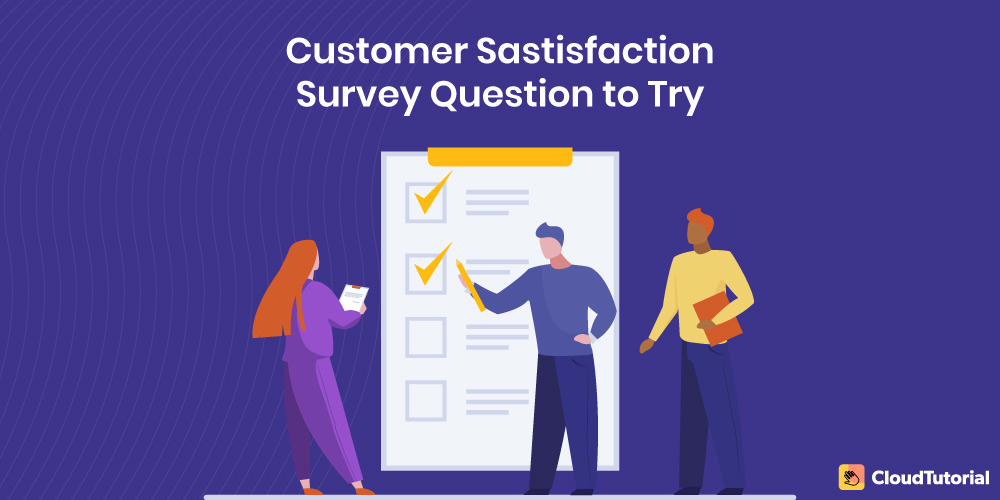
There are diverse methods to ask customer satisfaction survey questions, and each of them has its peculiar features. The question types involved in any survey are as follows:
Multiple-choice Questions
Multiple-choice questions put a limit on the total answers any responder can revert per question. The outcomes are easy to tabularize, and you are more probable to get a reply from a user as these types of questions need less effort to respond to than the open-ended ones, where the user has to type her or his answers.
Such questions can include an extensive range of question patterns such as rating scale questions, nominal questions, binary scale questions, semantic differential questions, and Likert scale questions. Along with the customer satisfaction survey examples, these type of questions are stated below:
Binary Scale Questions
Binary scale questions are contingent on a limit of two responses per query, therefore it is coined as ‘binary’. There are simple, yes or no questions. Such questions can be responded to with graphics such as with happy or sad face emojis or thumbs up or thumbs down. They function aptly to limit the vagueness that comes with subjective replies to rating scale queries.
An example of a binary scale question:
‘Did you get the product you were searching for on our site? Yes/No
Rating Scale Questions
As its name indicates, ordinal questions or rating scale questions are multiple-choice questions that depend on a scale for grading a feature of customer satisfaction.
It can be existent in the survey types – Net Promotion (NPS) and Customer Satisfaction Score (CSAT) surveys.
An instance of the former: Please rate ‘the possibility of you mentioning our products to a colleague or friend on a scale of 0 to 10.’
An instance of the latter: Please rate ‘how satisfied you were with your contact with our customer service representatives on a scale of 1 to 5.’
Likert Scale Questions
The Likert scale is generally a 5 point or 7 point scale utilized to assess how customers feel about a particular thing. Here, the bottom number ‘1’ signifies the lowest extreme view, whereas the highest number ‘5’ on a 5 point scale, signifies the highest extreme view. And the middle number ‘3’ on a 5 point scale shows more of a moderate view.
Example:
To what level do you agree with the below-mentioned statement:
(Product’s name) had an easy-to-understand instruction manual.
- Strongly Disagree
- Slightly Disagree
- Neither Agree Nor Disagree
- Slightly Agree
- Strongly Agree
Nominal Questions
Nominal questions classify diverse classifications of answers. These answers do not overlap unless you comprise an ‘all of the above’ option. Moreover, you cannot apply any numerical value to them. Such answers to any nominal question have no precise order; they are intended to carry importance for variable labels only.
Example:
How do you think we can enhance our service?
- Train chefs
- Better design
- More attractive plating
- New menu
Semantic Differential Questions
Similar to Likert scale queries, Semantic differential questions also present a 5 point or 7 point scale. However, such questions offer uniqueness by asking more descriptive responses. In this, you can ask the respondents to select the option that best embodies their attitude or opinion on a certain subject rather than asking them to merely agree or disagree.
Example:
How useful do you find our tutorials?
- Not Helpful at All
- Hardly Helpful
- Neither Helpful Nor Unhelpful
- Slightly Helpful
- Extremely Helpful
Open-ended Questions
Open-ended survey questions give respondents the liberty to write whatever they would like to. Such types of questions work well for assembling fresh ideas and ascertaining opportunities and issues you never recognized. This data is more challenging to the procedure, but there are copious practices to make evaluating open-ended questions simpler.
Generally, such queries ask for elaboration or clarity or on preceding ratings or multiple-choice questions. These questions are best utilized to curtail any vagueness or to research further into a matter without the requirement to ask manifold questions.
As the answer is in a section that consumers can type, they can freely express themselves and add the details prevailing in a concern, preference, or problem. The questions here are more challenging to process as it is unique and longer to every respondent. Nonetheless, it is brilliant for searching for new opportunities and ideas for betterment.
Example of an open-ended question:
Is there something on our website we could enhance for a better digital experience? If yes, what is it?
5 Questions to Ask in Your Customer Satisfaction Survey
If you wish to acquire constructive customer feedback, then you go to ask them the correct questions. Sharing any information is not an easy task, and it is not the consumer’s responsibility to offer your business useful criticism.
In its place, it is the inspector’s responsibility to generate a stimulating attempt that employs the participant. If you are getting confused on determining what to enquire your consumers, here are some of the questions to ask in your customer satisfaction survey:
1. Demographics Questions
Demographics play an essential aspect within sales and marketing teams as they make it simpler for enterprises to divide their customers into buyer personas. By assembling consumers based on main features, this classification aids employees understand the target audience easily.
Such sales and customer service teams can then utilize that data to follow leads that are most probable to convert. Below stated are some of the demographics questions that you must consider comprising in your survey:
- Where are you situated?
- If applicable, what gender do you identify as?
- What is your employment status?
- How old are you?
When questioning, be sure to hold an inclusive and proactive approach. Such questions should not be obligatory. Hence, always provide a choice for customers to neglect any answer. Your objective is to excerpt honest data, but you do not wish it to come at the cost of the consumer’s comfort.
2. Product Usage Questions
When we talk about customer satisfaction and success, your business must gather feedback about your service or product. If you do not, then it is tougher to measure customer needs and deliver operative solutions.
Discovering how content your users are with your delivery supplies your product and marketing teams with significant customer satisfaction data that can be utilized to augment customer retention. Below are a few questions that you can ask:
- Does the product line assist you to accomplish your goals?
- How repeatedly do you use the service or product?
- What would you enhance, if you could?
- What is your preferred portion or tool of the product or service?
Build an advanced knowledge base for your customers and give them answers fast – real fast.
Take your app and help center to the next level with CloudTutorial.
3. Open-text
The customer satisfaction survey questions that permit the participants to write their answers inside a text box are known as ‘Open-text’ questions. It sanctions users to express completely their views utilizing the consumer’s voice in place of the enterprise’s pre-written replies.
While they can be time-consuming to evaluate, such questions inspire the participants to be truthful and give them the liberty to address any subject. It can be an influential asset when defining the essential values of your consumers. Some of the open-text questions that you can plan in your survey are:
- How can we enhance your experience with the organization?
- In your words, describe how you feel about (company’s product or name)?
- Do you have any other feedback?
- What can our team of employees do better?
4. Satisfaction Questions
At times there are parts of your proposal or business that you need customer feedback on, but they are not the aspects that your customers are addressing actively. In such circumstances, it aids to be direct with your consumers and inquire them how they truly feel about such precise details.
Before that, you will have to decide on a quantifiable plan to ascertain their answers. Implementing a satisfaction scale unit is an excellent way to generate a reliable approach to measuring this particular survey feedback. Below are the few ways in which you can devise this scale:
- A descriptive scale that assesses a customer’s answer from the scale of unsatisfied to satisfied. Here, the customer is presented with a small list of answers to select from that choice from ‘very unsatisfied’ to ‘very satisfied’.
- A scale evaluating from 1 to 10, where 1 describes a very unsatisfied view and 10 means that the customer was extremely satisfied.
5. Longevity
In the last segment of this satisfaction survey, you might need to comprise queries about the stages that will occur after the submission. Such customer survey questions let your team follow-up with all the participants. These types of queries can be phrased in some of the different ways mentioned below:
- In the upcoming days, would you be agreeable to take such a survey again?
- If we were to insert a product feature, could we connect to let you know about such changes?
- May we communicate with you to follow-up on these replies?
Customer Satisfaction Survey: Next Steps
If you require to get the best out of your customer surveys, then you must follow certain tips and customer satisfaction survey templates. Confirm that surveys are concise enough to entice customers and induce them to take it readily in the first place.
Let’s discover some of the vital steps that can enhance the effectiveness of these surveys:
- From the above-mentioned types of survey, opt for the right type that fulfills your business needs.
- Make it a steady practice to perform these surveys monthly, quarterly, or annually.
- Produce an accurate set of questions that aid you gain both qualitative and quantitative user feedback.
- Send a ‘Thank you note’ to consumers for finishing the survey with a ‘follow-up note’ in respect to their feedback. This will assist you to confirm that they would participate in such kinds of surveys always.
- Conduct activities based on a particular survey. These survey questions would be of no importance if you do not take active measures to enhance the feedback you received from the customers.
- Optimize the number of questions to uphold the right balance between how much data you require and avert them from the survey exhaustion.
Customer Satisfaction Survey Template
There are numerous customer survey templates accessible online that help to understand customers by getting informed about their opinions. This will let you visualize their pain points and take apt actions accordingly to augment your business services.
Below mentioned are five types of customer satisfaction survey templates that you can incorporate.
- Net Promoter Score Survey Template
- Customer Effort Score Survey Template
- Customer Satisfaction Survey Template
- Retention Survey Template
- Point-of-conversion Template
FAQs
- Select an apt survey type
- Pick the precise customer satisfaction survey questions
- Enquire for customer feedback frequently
- Consider diverse ways to ask questions
- Test your survey
- Restrict the number of survey queries
- Send surveys at the correct time in the customer expedition
Conclusion
Conducting a customer satisfaction survey at regular intervals is a smart method which companies must follow to obtain feedback from the individuals who matter to you the most – your customers.
Contact CloudTutorial to get the best practices inculcated in creating any survey. We will help you multiply the survey response rates that will let you take the necessary steps to maintain customer retention.
Try it out before you decide.
Create a test article NOW!
Using this tool, all you have to do is add your first test article and see how it looks. Now, you don’t have to sign-up or login into CloudTutorial software just to check how your first article appears.
